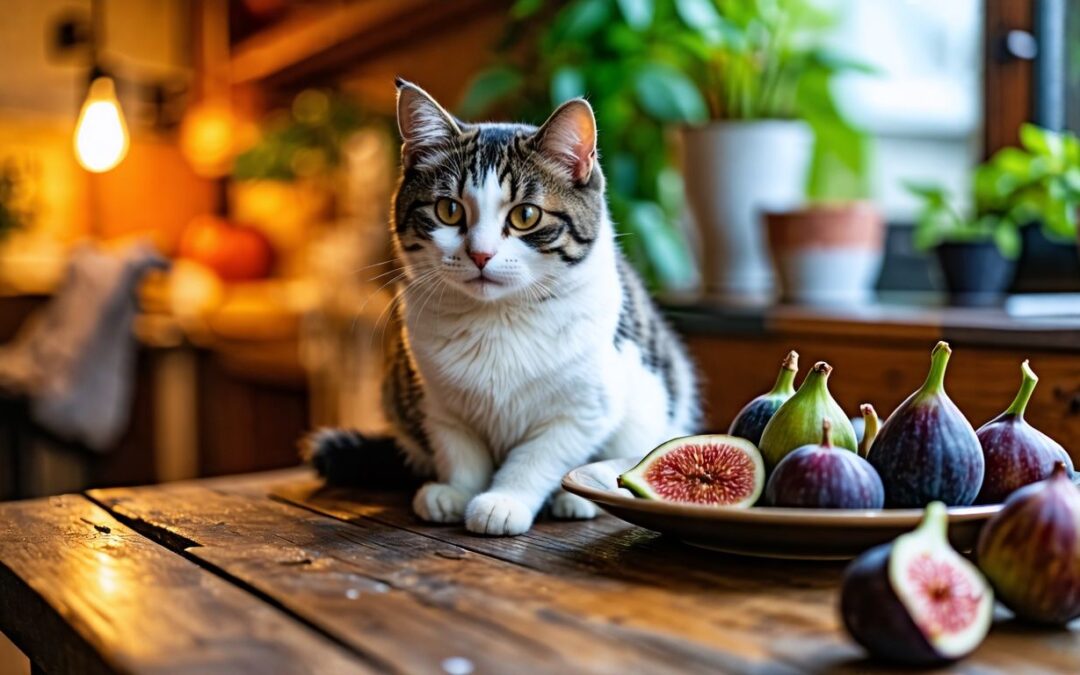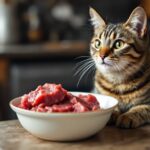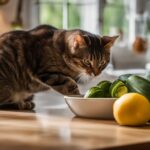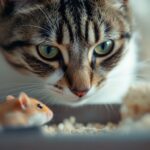Are you wondering, “Can cats eat figs?” It’s a common question for pet owners who want to share their snacks with their furry friends. Figs are not ideal for cats since they thrive on a diet mainly comprising animal proteins.
This article will guide you through the ins and outs of why figs might not be the best treat for your cat and what to do if they sneak a bite. Keep reading to ensure your cat stays healthy and happy!
Key Takeaways
- Figs can cause health problems for cats because they contain substances like ficain that irritate their gastrointestinal system. This irritation might lead to vomiting or diarrhea.
- All parts of the fig plant, including the fruit, leaves, and sap, are toxic to cats. Keeping these plants out of reach is vital to prevent your cat from getting sick.
- If a cat eats figs or any part of the fig plant, immediate veterinary care is necessary. Signs of distress such as vomiting, diarrhea, or lethargy require prompt attention.
- Fig Newton cookies are not a safe treat for cats due to their sugar content and other additives which could upset a cat’s stomach even though the cooking process reduces some risks.
- Cats need diets high in animal proteins and don’t require fruits like figs. Offering them foods suited to their nutritional needs helps keep them healthy and avoids potential digestive issues.
Toxicity of Figs for Cats
Figs can be harmful to cats. These fruits contain compounds that may lead to digestive issues and other health problems.
What makes figs toxic to cats?
Figs contain a substance called ficain, which can be irritating to a cat’s gastrointestinal system. This irritation may lead to vomiting or diarrhea if a cat ingests figs. All parts of the fig plant, including the fruit, leaves, and sap, can be harmful.
Fig leaves are particularly toxic to cats and pose additional health risks.
Cats are obligate carnivores, meaning their diets should primarily consist of animal proteins with minimal carbohydrates. Figs do not provide any essential nutrients for them. Even cooked figs have reduced ficain levels but still carry some risk if consumed by cats.
It is best to avoid feeding figs altogether and keep fig plants out of reach to prevent accidental ingestion.
Effects of fig ingestion on cats
Ingestion of figs can lead to several health issues for cats. All parts of the fig plant, including fresh and dried figs, contain substances that are toxic and irritating to them. This can result in gastrointestinal issues such as vomiting or diarrhea.
Some cats may experience more severe reactions if they consume larger quantities. The sap from fig plants can also be a mild irritant to mammals, further complicating any health concerns.
Fig leaves pose an additional risk if ingested by cats. These leaves contain compounds that are harmful and can cause significant discomfort. Effects may include swelling or irritation in their mouths or digestive tracts.
Owners should be aware that there is almost no reason why cats should eat fruit at all since their ideal diet mainly consists of animal proteins with minimal carbohydrates. Keeping figs and all related plants out of reach is essential for maintaining cat health concerns related to potential toxicity from these sources.
Potential health concerns
Figs can pose several health concerns for cats. All parts of the fig plant, including the fruit and leaves, are toxic and irritating to them. Ingesting figs can lead to gastrointestinal issues such as vomiting or diarrhea.
Fig leaves contain compounds that may cause more severe reactions in cats if consumed. The sap from fig trees can be a mild irritant as well. Keeping these plants out of reach is essential for pet safety since feline diets should not include potentially harmful foods like figs.
Understanding what to do if your cat eats figs is crucial for every pet owner.
What to Do If Your Cat Eats Figs
If your cat eats figs, take action quickly. Remove any remaining fig pieces and monitor your pet for signs of distress.
Immediate actions to take
Act quickly if your cat eats figs. Remove any remaining fig pieces from their reach to prevent further ingestion. Monitor your cat for signs of distress or discomfort, as fig leaves and the sap can irritate them.
Contact your veterinarian immediately if you notice any symptoms like vomiting, diarrhea, or gastrointestinal issues. Fig trees and all parts of the fig plant are toxic to cats; timely action is crucial for their safety.
Seeking veterinary care ensures that your pet receives proper treatment without delay.
Seeking veterinary care
Immediate veterinary care is crucial if your cat has eaten figs or any part of the fig plant. All parts of the fig are toxic and irritating to cats, including the leaves and fruits.
If your feline companion shows signs of distress, such as vomiting, diarrhea, or lethargy, seek help right away. Pet nutrition should focus on animal proteins; therefore, unusual ingestion can lead to gastrointestinal issues.
The ASPCA provides valuable information on animal poisoning related to fig plants. If you suspect that your cat has consumed figs, contacting a veterinarian ensures proper assessment and treatment.
Timely action can prevent serious health concerns associated with ingesting these potentially harmful substances.
Other Factors to Consider
Figs aren’t just food; they can also come from fig trees and leaves that pose risks to cats. Fig Newtons contain sugar and other ingredients that could upset a cat’s stomach.
Fig trees and fig leaves
Fig trees, known scientifically as Ficus Carica, are not considered poisonous to mammals. Nevertheless, the sap of these trees can be a mild irritant. Fig leaves pose a greater risk for cats as they contain toxic compounds that can lead to gastrointestinal issues if ingested.
All parts of the fig plant are irritating and potentially harmful. This includes fresh figs, dried figs, and fig seeds. Keeping fig plants out of reach helps prevent accidental consumption by curious cats.
Understanding the risks associated with cat diet is crucial for pet owners. Ensuring that pets do not have access to toxic plants like figs promotes better health and safety in your home environment.
Fig Newtons
Fig Newtons contain figs, but they are not suitable for cats. The ingredients found in Fig Newtons can be unhealthy and sometimes harmful to felines. Cats do not need fruits as part of their diet, and most commercial snacks lack the nutrients essential for their health.
Feeding your cat Fig Newtons may lead to gastrointestinal issues due to the high sugar content and other additives.
Safety is a concern since all parts of the fig plant, including those used in processed products like Fig Newtons, can irritate cats. Although these cookies are cooked—potentially reducing ficain levels—they still pose risks for your pet’s health.
Avoid giving Fig Newtons or any similar treats to ensure that your feline friend stays safe and healthy.
Conclusion
Cats should not eat figs or any part of the fig plant. Figs can be irritating and harmful to their health. It’s always best to keep these fruits and plants out of their reach. If your cat does ingest a fig, seek veterinary advice promptly.
Keeping our furry friends safe is what matters most!
FAQs
1. Can cats eat figs?
Yes, cats can eat figs but in very small amounts. However, it’s essential to monitor your cat for any gastrointestinal issues that may arise.
2. Are fig leaves harmful to cats?
Ingesting fig leaves can be toxic for cats as they might cause digestive problems. It’s best not to let your cat near a fig tree or chew on its leaves.
3. Is it safe for cats to consume dried or fresh figs?
Cats can have both dried and fresh figs but only in tiny portions. Too much of these fruits might upset their stomach.
4. What about Fig Newtons? Can my cat have those?
While Fig Newton cookies contain real fruit, they also include ingredients that are unhealthy for felines, so it’s better not to feed them Fig Newtons.
5. Can Cats Eat other fruits and vegetables apart from figs?
Cats can eat certain fruits and vegetables; however, some are toxic to them just like the case with the potential toxicity of the Fig tree or plant parts such as seeds and leaves.






